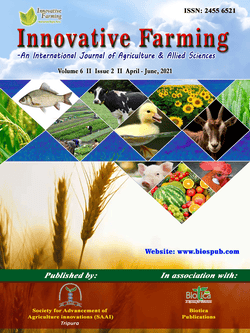
Impact of Bio-Fortified Maize on Silage Quality, Milk Production and Economics in Mild-Tropical Humid Climate of Tripura
Sanjay Kumar Ray*
ICAR-Krishi Vigyan Kendra, South Tripura, Birchandramanu, South Tripura, Tripura (799 144), India
Anup Das
ICAR-Research Complex for NEH Region, Tripura Centre, Lembucherra, Tripura (799 210), India
Animesh Sarkar
ICAR-Research Complex for NEH Region, Tripura Centre, Lembucherra, Tripura (799 210), India
Rubai Podder
ICAR-Research Complex for NEH Region, Tripura Centre, Lembucherra, Tripura (799 210), India
Vinay Singh
ICAR-Research Complex for NEH Region, Tripura Centre, Lembucherra, Tripura (799 210), India
B. Debnath
ICAR-Krishi Vigyan Kendra, South Tripura, Birchandramanu, South Tripura, Tripura (799 144), India
B. Das
ICAR-Research Complex for NEH Region, Tripura Centre, Lembucherra, Tripura (799 210), India
DOI: NIL
Keywords: Biofortified maize, Feed quality, Fodder, Income, Milk production, Silage
Abstract
Bio-fortified maize is supplemented with high-quality protein and contains appreciable amounts of tryptophan, lysine and pro-vitamin A than the conventional maize varieties and hybrids. Hence, cultivation of bio-fortified maize as food-feed crop may enhance quality of feed-fodder and milk in addition to improvement in productivity and income of farmers. A study was conducted with 5 varieties at 3 locations in the South Tripura district during the kharif and rabi seasons of 2020-21, including three bio-fortified maize hybrids (LQMH 1, Vivek QPM 9 Improved and HQPM 5 Improved), a traditional hybrid (Sujata) and a high yielding composite variety (DA 61A). The purpose of the study was to determine the usefulness of bio-fortified maize in terms of production, its acceptability as feed and its effects on milk production and farmer income. In comparison to the high yielding composite variety, bio-fortified maize's performance was determined to be suitable, with greater yield (3.23-4.15 t ha-1) and B:C ratio (2.02-2.59:1). However, highest yield (4.23 t ha-1) and B:C ratio (2.64:1) was recorded with traditional hybrid (Sujata). Utilizing bio-fortified green fodder maize to prepare silage increased net return by 80 to 98% above conventional maize grain production. The quality silage prepared using green maize was good because of its sweet and sour, faint green or brownish colour and acidic pH (3.60-4.20). Silage feeding to dairy animals for a continuous four months raised average milk production by 38.2 to 53.1%, resulting in an increase in daily income cow-1 of Rs. 190 to Rs. 255. Due to its suitability as feed-fodder, milk production, income and socio-economic status of the farmers, the cultivation of bio-fortified maize and the preparation of feeds for dairy animals might be advised for the dairy farmer in mild-Tropical humid climate of Tripura.
Downloads
not found
Reference
Chaudhary, D.P., Jat, S.L., Kumar, R., Kumar, A., Kumar, B., 2014. Fodder quality of maize: its preservation. In: Maize: Nutrition Dynamics and Novel Uses. (Eds.) Chaudhary, D.P., Kumar, S., Singh, S. Springer, India, pp. 153-160. DOI: https://doi.org/10.1007/978-81-322-1623-0_13.
Lobell, D., Cassman, K., Field, C., 2009. Crop yield gaps: Their importance, magnitudes, and causes. Annual Review of Environment and Resources 34, 179-204. DOI: https://doi.org/10.1146/annurev.environ.041008.093740.
Mc Donald, K.A., Nicholas, P.K., Kidd, J.M., Penno, J.W., Napper, A.R., 2000. The effect of pasture silage quality on milk production and live weight gain of dairy cattle. Proceedings of the New Zealand Society of Animal Production 60, 253-255.
